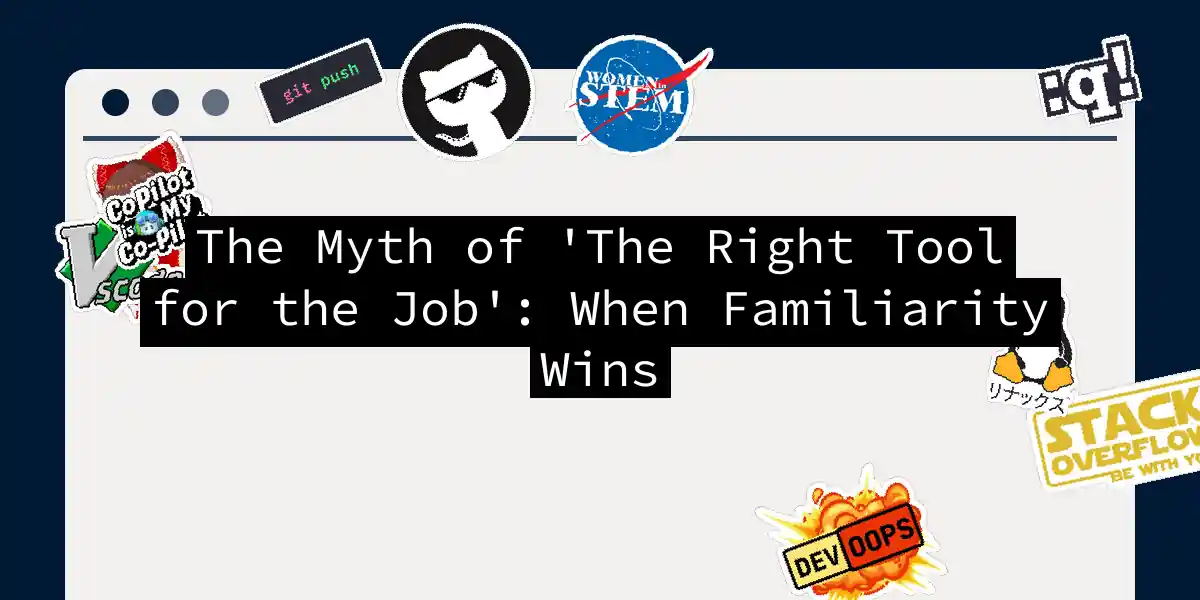The Illusion of Perfection
In the world of software development, the phrase “the right tool for the job” is often tossed around with the confidence of a seasoned carpenter wielding a trusty hammer. However, beneath this seemingly straightforward advice lies a complex web of assumptions, trade-offs, and practical realities that make this mantra more myth than truth.
The Assumption Trap
When we say “the right tool for the job,” we often assume a level of certainty that rarely exists in real-world projects. Projects are dynamic, and their scopes can change like the weather. As Joseph Woodward aptly points out, “No one can predict the future, so why use a language that implies unquestionable certainty?”.
This assumption ignores the inherent variability of software development. You might have read the project specification, but how many times have you seen the requirements change mid-project? The truth is, building software is about making the right trade-offs given various constraints like time, cost, and risk. There are no absolute “right” or “wrong” solutions, just ones that make the best trade-offs under the circumstances.
The Comfort Zone
Familiarity is a powerful force in tool selection. Developers often stick with what they know, not because it’s the absolute best tool, but because it’s what they are most comfortable with. Learning new tools, especially programming languages, databases, or frameworks, is a significant investment of time, money, and effort. As Peter Lyons notes, “Learning new programming languages is hard and takes time, money, effort, and determination. Even then, many developers never achieve a level of capability and confidence that matches their primary language.”.
This comfort zone extends to teams as well. When a team is proficient in a particular set of tools, switching to new ones can be counterproductive. The switching cost can be high, especially with databases, where the operational and development complexities can lead to slow development speeds, slow queries, or operational issues.
The Tool Shed Dilemma
Imagine a tool shed, not just any tool shed, but an 8x8 one, filled to the brim with every tool imaginable. Sounds ideal, right? But in reality, having too many tools can be overwhelming. You can’t master every tool, and each tool requires space to store, maintain, and repair. In software development, this translates to a core set of tools that do most of what you need adequately, even if not perfectly.
The Myth of the Best Tool
The idea of a single “best” tool for a job is misleading. What might be the best tool in one context could be suboptimal in another. For instance, Ruby might be perfect for a web application but utterly inappropriate for writing an operating system. The choice of tool is often a combination of what the team knows well and what the project requires, rather than an absolute best fit.
Ecosystem and Community
The ecosystem and community around a tool also play a significant role. For example, if you’re doing academic research, Python might be the better choice simply because it’s the default accepted by that community. This doesn’t mean Python is inherently better; it just means you’re rowing with the current rather than against it.
Practical Considerations
In the real world, the decision to use a particular tool is rarely based on theoretical perfection. It’s about being productive with what you know. Here’s a step-by-step thought process that reflects this practicality:
- Identify the Job: Clearly define the project requirements and the specific tasks involved.
- Evaluate Tools: List potential tools that could handle the job, considering both their capabilities and your team’s familiarity.
- Assess Trade-offs: Weigh the pros and cons of each tool, including learning curves, operational costs, and community support.
- Choose the Best Fit: Select the tool that best balances your needs with your team’s expertise.
Conclusion
The notion of “the right tool for the job” is more of a guiding principle than a hard and fast rule. In practice, it’s often about using the tools you know well enough to be productive, rather than chasing an elusive perfect fit. By acknowledging the complexities and trade-offs involved, we can make more informed decisions that balance our needs with our capabilities.
So, the next time you hear someone say “use the right tool for the job,” remember that it’s not about finding the absolute best tool, but about making the best choice given your constraints and expertise. And if that means sticking with what you know, well, that’s just fine. After all, as the saying goes, “if it ain’t broke, don’t fix it.” But if it is broke, maybe it’s time to learn a new tool—or at least, to learn how to use the old one better.
